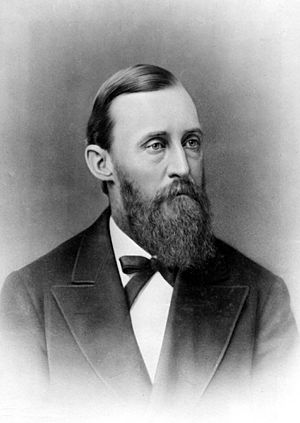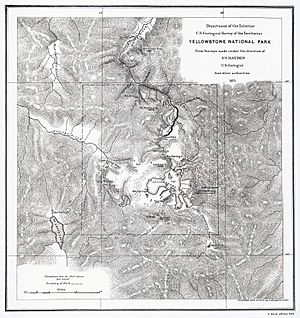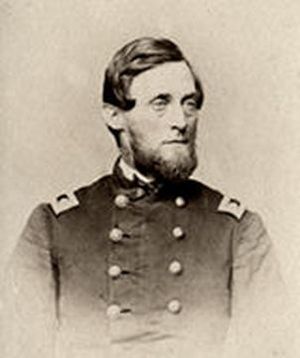Ferdinand Vandeveer Hayden facts for kids
Quick facts for kids
Ferdinand Vandeveer Hayden
|
|
|---|---|

Hayden in 1870
|
|
| Born | September 7, 1829 Westfield, Massachusetts, U.S.
|
| Died | December 22, 1887 (aged 58) |
| Other names | "Man Who Picks Up Stones Running" |
| Known for | Survey expeditions of the Rocky Mountains |
| Scientific career | |
| Fields | Geology |
Ferdinand Vandeveer Hayden (born September 7, 1829 – died December 22, 1887) was an important American geologist. He was famous for leading early expeditions to explore the Rocky Mountains in the late 1800s. Hayden was also a doctor who worked for the Union Army during the American Civil War.
Contents
Early Life and Education
Ferdinand Hayden was born in Westfield, Massachusetts. As a young boy, he loved nature and wildlife. This interest later led him to study medicine.
He graduated from Oberlin College in 1850. Then, he finished his medical studies at Albany Medical College in 1853. There, a professor named James Hall noticed his talent. Hall was a state geologist in New York.
Professor Hall encouraged Hayden to join an exploration trip to Nebraska Territory. On this trip, Hayden studied geology and collected fossils. This was his first big geology adventure in 1853.
Hayden later spent the rest of the 1850s on different trips. He explored and collected samples in the northern Missouri River areas. In 1856 and 1857, he joined expeditions led by Lieutenant Gouverneur K. Warren. In 1859, he was part of the Raynolds Expedition.
During the American Civil War, Hayden served as an army surgeon. He became the chief medical officer for the Union Army of the Shenandoah. He even received an honorary promotion to lieutenant colonel.
Exploring the American West

After the Civil War, Ferdinand Hayden led important surveys for the United States government. These surveys explored the geography and geology of the Nebraska and Western Territories. In 1867, he became the head geologist for the United States Geological and Geographical Survey of the Territories.
Hayden had led expeditions into the Rocky Mountains before and after the war. In 1869, he led a trip along the Front Range to Denver and Sante Fe. In 1870, he received money from the government for a 20-person expedition. This trip went to places like South Pass and Fort Bridger.
To measure distances on their journeys, Hayden used an odometer. This device was attached to a cart pulled by a mule. It measured how far the cart wheels rolled. Even with rough land, it was fairly accurate.
Yellowstone National Park Survey

In 1871, Hayden led America's first government-funded geological survey into the Yellowstone region. This area is in northwestern Wyoming. President Ulysses S. Grant's Secretary of Interior, Columbus Delano, gave the directions for this survey.
The survey team had about 50 men. Famous people like painter Thomas Moran and photographer William Henry Jackson were part of it. Jackson took amazing large photographs. Moran created dramatic paintings of the area.
In 1872, Hayden's work helped convince Congress to create Yellowstone. It became the first U.S. National Park. His reports, along with Jackson's photos and Moran's paintings, were very important. These publications also encouraged people to move westward in the United States.
Hayden's Legacy
Hayden worked for twelve years on these annual survey trips. His efforts resulted in many valuable books about natural history and science. In 1877, he published his Geological and Geographical Atlas of Colorado. The last of his yearly survey trips was in 1878.
Because of Hayden's extensive geological work, he found many dinosaur fossils. He brought these fossils back east for scientists to study. Much of what he collected is still kept at the Smithsonian Institution. American paleontologist Joseph Leidy received most of his fossil samples from Hayden.
Later Life and Honors
Hayden was elected to the American Philosophical Society in 1860. In 1865, he became a geology professor at the University of Pennsylvania. He was also elected a member of the American Antiquarian Society in 1873. In 1879, he became a Foreign Member of the Geological Society of London.
When the United States Geological Survey was formed in 1879, he worked as one of its geologists for seven years. Ferdinand Hayden passed away in Philadelphia on December 22, 1887. He is buried at The Woodlands Cemetery.
Many places are named after Ferdinand Hayden to honor his work. Hayden Valley in Yellowstone National Park is named for him. The town of Hayden, Colorado, is also named after him. Several mountain peaks bear his name too.
Some plants and animals were named in his honor. The sedge Carex haydeniana was named for him in 1871. A type of garter snake, Thamnophis radix haydenii, was named for him in 1860. A land snail, Oreohelix haydeni, was named in 1869. Hayden Hall at the University of Pennsylvania, which once housed the dental school, now holds the bioengineering and earth sciences departments.
See also
 In Spanish: Ferdinand Vandeveer Hayden para niños
In Spanish: Ferdinand Vandeveer Hayden para niños


